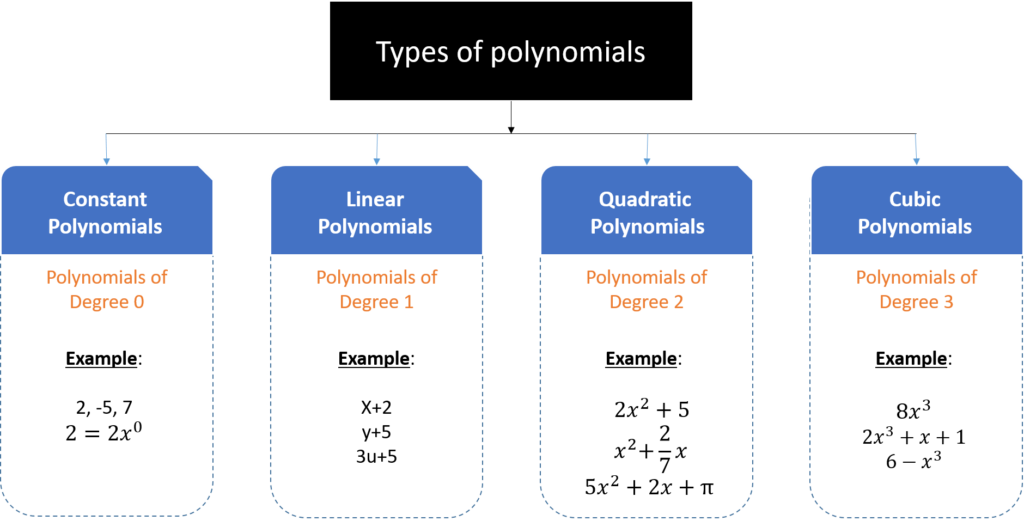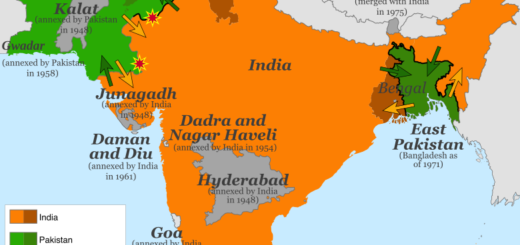Polynomials
- Polynomials
- Introduction
- Polynomials In One Variable
- Zeroes Of A Polynomial
- Remainder Theorem
- Factorisation Of Polynomials
- Algebraic Identities
- Summary
Polynomial is an algebraic expression that includes constants, variables, and exponents. It is the expression in which the variables have only positive integral.
Example
- 4x3 + 3x2 + x +3 is a polynomial in variable x.
- 4x2 + 3x-1 – 4 is not a polynomial as it has negative power.
- 3x3/2 + 2x – 3 is not a polynomial.

- Polynomials are denoted by p(x), q(x) etc.
- In the above polynomial 2x2, 3y and 2 are the terms of the polynomial.
- 2 and 3 are the coefficient of the x2 and y respectively.
- x and y are the variables.
- 2 is the constant term which has no variable.
Polynomials in One Variable
If there is only one variable in the expression, then this is called the polynomial in one variable.
Example
- x3 + x – 4 is polynomial in variable x and is denoted by p(x).
- r2 + 2 is polynomial in variable r and is denoted by p(r).
Types of polynomials on the basis of the number of terms
| Number of non zero terms | Name | Example |
|---|---|---|
| 0 | Zero Polinomial | 0 |
| 1 | Monomial | X2 |
| 2 | Binomial | X2+1 |
| 3 | Trinomial | X3+1 |
Types of polynomials on the basis of the number of degrees
The highest value of the power of the variable in the polynomial is the degree of the polynomial.

Zeroes of a Polynomial
If p(x) is a polynomial, then the number ‘a’ will be the zero of the polynomial with p(a) = 0. We can find the zero of the polynomial by equating it to zero.
Example: 1
Given polynomial is p(x) = x – 4
To find the zero of the polynomial we will equate it to zero.
x – 4 = 0
x = 4
p(4) = x – 4 = 4 – 4 = 0
This shows that if we place 4 in place of x, we got the value of the polynomial as zero. So 4 is the zero of this polynomial. And also we are getting the value 4 by equating the polynomial by 0.
So 4 is the zero of the polynomial or root of the polynomial.
The root of the polynomial is basically the x-intercept of the polynomial.

If the polynomial has one root, it will intersect the x-axis at one point only and, if it has two roots then it will intersect at two points and so on.
Example: 2
Find p (1) for the polynomial p (t) = t2 – t + 1
p (1) = (1)2 – 1 + 1
= 1 – 1 + 1
= 1
Example 2.1
Which of the following expressions are polynomials in one variable and which are not? State reasons for your answer.
(i) 4x2 – 3x + 7
(ii) y2 + √2
(iii) 3 √t + t√2
(iv) y+ 2/y
(v) x10+ y3+t50
Solution:
(i) We have 4x2 – 3x + 7 = 4x2 – 3x + 7x0
It is a polynomial in one variable i.e., x
because each exponent of x is a whole number.
(ii) We have y2 + √2 = y2 + √2y0
It is a polynomial in one variable i.e., y
because each exponent of y is a whole number.
(iii) We have 3 √t + t√2 = 3 √t1/2 + √2.t
It is not a polynomial, because one of the exponents of t is 1/2,
which is not a whole number.
(iv) We have y + y+2/y = y + 2.y-1
It is not a polynomial, because one of the exponents of y is -1,
which is not a whole number.
(v) We have x10+ y3 + t50
Here, the exponent of every variable is a whole number, but x10 + y3 + t50 is a polynomial in x, y, and t, i.e., in three variables.
So, it is not a polynomial in one variable.
2. Write the coefficients of x2 in each of the following
(i) 2 + x2 + x
(ii) 2 – x2 + x3
(iii) π/2 x2 + x
(iv) √2 x – 1
Solution:
(i) The given polynomial is 2 + x2 + x.
The coefficient of x2 is 1.
(ii) The given polynomial is 2 – x2 + x3.
The coefficient of x2 is -1.
(iii) The given polynomial is π/2 x 2 + x.
The coefficient of x2 is π/2.
(iv) The given polynomial is √2 x – 1.
The coefficient of x2 is 0.
3. Give one example each of a binomial of degree 35, and of a monomial of degree 100.
Solution:
(i) A binomial of degree 35 can be 3x35 -4.
(ii) A monomial of degree 100 can be √2y100.
4. Write the degree of each of the following polynomials.
(i) 5x3+4x2 + 7x
(ii) 4 – y2
(iii) 5t – √7
(iv) 3
Solution:
(i) The given polynomial is 5x3 + 4x2 + 7x.
The highest power of the variable x is 3.So, the degree of the polynomial is 3.
(ii) The given polynomial is 4- y2. The highest power of the variable y is 2.
So, the degree of the polynomial is 2.
(iii) The given polynomial is 5t – √7 . The highest power of variable t is 1. So, the degree of the polynomial is 1.
(iv) Since, 3 = 3x° [∵ x°=1]
So, the degree of the polynomial is 0.
5. Classify the following as linear, quadratic and cubic polynomials.
(i) x2+ x
(ii) x – x3
(iii) y + y2+4
(iv) 1 + x
(v) 3t
(vi) r2
(vii) 7x3
Solution:
(i) The degree of x2 + x is 2. So, it is a quadratic polynomial.
(ii) The degree of x – x3 is 3. So, it is a cubic polynomial.
(iii) The degree of y + y2 + 4 is 2. So, it is a quadratic polynomial.
(iv) The degree of 1 + x is 1. So, it is a linear polynomial.
(v) The degree of 3t is 1. So, it is a linear polynomial.
(vi) The degree of r2 is 2. So, it is a quadratic polynomial.
(vii) The degree of 7x3 is 3. So, it is a cubic polynomial.
Example 2.2
- Find the value of the polynomial 5x – 4x2 + 3 at
(i) x = 0
(ii) x = – 1
(iii) x = 2
Solution:
1et p(x) = 5x – 4x2 + 3
(i) p(0) = 5(0) – 4(0)2 + 3
= 0 – 0 + 3
= 3
Thus, the value of 5x – 4x2 + 3 at x = 0 is 3.
(ii) p(-1) = 5(-1) – 4(-1)2 + 3
= – 5x – 4x2 + 3
= -9 + 3
= -6
Thus, the value of 5x – 4x2 + 3 at x = -1 is -6.
(iii) p(2) = 5(2) – 4(2)2 + 3
= 10 – 4(4) + 3
= 10 – 16 + 3
= -3
Thus, the value of 5x – 4x2 + 3 at x = 2 is – 3.
2. Find p (0), p (1) and p (2) for each of the following polynomials.
(i) p(y) = y2 – y +1
(ii) p (t) = 2 +1 + 2t2 -t3
(iii) P (x) = x3
(iv) p (x) = (x-1) (x+1)
Solution:
(i) Given that p(y) = y2 – y + 1.
∴ P(0) = (0)2 – 0 + 1 = 0 – 0 + 1 = 1
p(1) = (1)2 – 1 + 1 = 1 – 1 + 1 = 1
p(2) = (2)2 – 2 + 1 = 4 – 2 + 1 = 3
(ii) Given that p(t) = 2 + t + 2t2 – t3
∴p(0) = 2 + 0 + 2(0)2 – (0)3
= 2 + 0 + 0 – 0=2
P(1) = 2 + 1 + 2(1)2 – (1)3
= 2 + 1 + 2 – 1 = 4
p( 2) = 2 + 2 + 2(2)2 – (2)3
= 2 + 2 + 8 – 8 = 4
(iii) Given that p(x) = x3
∴ p(0) = (0)3 = 0, p(1) = (1)3 = 1
p(2) = (2)3 = 8
(iv) Given that p(x) = (x – 1)(x + 1)
∴ p(0) = (0 – 1)(0 + 1) = (-1)(1) = -1
p(1) = (1 – 1)(1 +1) = (0)(2) = 0
P(2) = (2 – 1)(2 + 1) = (1)(3) = 3
3. Verify whether the following are zeroes of the polynomial, indicated against them.
(i) p(x) = 3x + 1,x = –1/3
(ii) p (x) = 5x – π, x = 4/5
(iii) p (x) = x2 – 1, x = x – 1
(iv) p (x) = (x + 1) (x – 2), x = – 1,2
(v) p (x) = x2, x = 0
(vi) p (x) = 1x + m, x = – m/1
(vii) P (x) = 3x2 – 1, x = – 1/√3,2/√3
(viii) p (x) = 2x + 1, x = ½
Solution:
(i) We have , p(x) = 3x + 1

(ii) We have, p(x) = 5x – π
∴ p(−1/3)=3(−1/3)+1=−1+1=0
(iii) We have, p(x) = x2 – 1
∴ p(1) = (1)2 – 1 = 1 – 1=0
Since, p(1) = 0, so x = 1 is a zero of x2 -1.
Also, p(-1) = (-1)2 -1 = 1 – 1 = 0
Since p(-1) = 0, so, x = -1, is also a zero of x2 – 1.
(iv) We have, p(x) = (x + 1)(x – 2)
∴ p(-1) = (-1 +1) (-1 – 2) = (0)(- 3) = 0
Since, p(-1) = 0, so, x = -1 is a zero of (x + 1)(x – 2).
Also, p( 2) = (2 + 1)(2 – 2) = (3)(0) = 0
Since, p(2) = 0, so, x = 2 is also a zero of (x + 1)(x – 2).
(v) We have, p(x) = x2
∴ p(o) = (0)2 = 0
Since, p(0) = 0, so, x = 0 is a zero of x2. (vi) We have, p(x) = lx + m

(vii) We have, p(x) = 3x2 – 1

(viii) We have, p(x) = 2x + 1
∴ p(1/2)=2(1/2)+1=1+1=2
Since, p(1/2) ≠ 0, so, x = 12 is not a zero of 2x + 1.
4. Find the zero of the polynomial in each of the following cases
(i) p(x)=x+5
(ii) p (x) = x – 5
(iii) p (x) = 2x + 5
(iv) p (x) = 3x – 2
(v) p (x) = 3x
(vi) p (x)= ax, a≠0
(vii) p (x) = cx + d, c ≠ 0 where c and d are real numbers.
Solution:
(i) We have, p(x) = x + 5. Since, p(x) = 0
⇒ x + 5 = 0
⇒ x = -5.
Thus, zero of x + 5 is -5.
(ii) We have, p(x) = x – 5.
Since, p(x) = 0 ⇒ x – 5 = 0 ⇒ x = -5
Thus, zero of x – 5 is 5.
(iii) We have, p(x) = 2x + 5. Since, p(x) = 0
⇒ 2x + 5 =0
⇒ 2x = -5
⇒ x = −5/2
Thus, zero of 2x + 5 is −5/2 .
(iv) We have, p(x) = 3x – 2. Since, p(x) = 0
⇒ 3x – 2 = 0
⇒ 3x = 2
⇒ x = 2/3
Thus, zero of 3x – 2 is 2/3
(v) We have, p(x) = 3x. Since, p(x) = 0
⇒ 3x = 0 ⇒ x = 0
Thus, zero of 3x is 0.
(vi) We have, p(x) = ax, a ≠ 0.
Since, p(x) = 0 => ax = 0 => x-0
Thus, zero of ax is 0.
(vii) We have, p(x) = cx + d. Since, p(x) = 0
⇒ cx + d = 0 ⇒ cx = -d ⇒ x=−d/c
Thus, zero of cx + d is –d/c
Example 2.3
Find the remainder when x3 + 3x2 + 3x + 1 is divided by
(i) x + 1
(ii) x – 1/2
(iii) x
(iv) x + π
(v) 5 + 2x
Solution:
Let p(x) = x3 + 3x2 + 3x +1
(i) The zero of x + 1 is -1.
∴ p(-1) = (-1)3 + 3(-1)2 + 3(-1) +1
= -1 + 3- 3 + 1 = 0
Thus, the required remainder = 0
(ii) The zero of x−12 is 12

Thus, the required remainder = 27/8
(iii) The zero of x is 0.
∴ p(0) = (0)3 + 3(0)2 + 3(0) + 1
= 0 + 0 + 0 + 1 = 1
Thus, the required remainder = 1.
(iv) The zero of x + π is -π.
p(-π) = (-π)3 + 3(- π)22 + 3(- π) +1
= -π3 + 3π2 + (-3π) + 1
= – π3 + 3π2 – 3π +1
Thus, the required remainder is -π3 + 3π2 – 3π+1.
(v) The zero of 5 + 2x is −5/2 .


Thus, the required remainder is −27/8 .
2. Find the remainder when x3 – ax2 + 6x – a is divided by x – a.
Solution:
We have, p(x) = x3 – ax2 + 6x – a and zero of x – a is a.
∴ p(a) = (a)3 – a(a)2 + 6(a) – a
= a3 – a3 + 6a – a = 5a
Thus, the required remainder is 5a. 3. Check whether 7 + 3x is a factor of 3x3+7x.
Solution:
We have, p(x) = 3x3+7x. and zero of 7 + 3x is −7/3.

Since,( −490/9) ≠ 0
i.e. the remainder is not 0.
∴ 3x3 + 7x is not divisib1e by 7 + 3x.
Thus, 7 + 3x is not a factor of 3x3 + 7x.
Example 2.4
- Determine which of the following polynomials has (x +1) a factor.
(i) x3+x2+x +1
(ii) x4 + x3 + x2 + x + 1
(iii) x4 + 3x3 + 3x2 + x + 1
(iv) x3 – x2 – (2 +√2 )x + √2
Solution:
The zero of x + 1 is -1.
(i) Let p (x) = x3 + x2 + x + 1
∴ p (-1) = (-1)3 + (-1)2 + (-1) + 1 .
= -1 + 1 – 1 + 1
⇒ p (- 1) = 0
So, (x+ 1) is a factor of x3 + x2 + x + 1.
(ii) Let p (x) = x4 + x3 + x2 + x + 1
∴ P(-1) = (-1)4 + (-1)3 + (-1)2 + (-1)+1
= 1 – 1 + 1 – 1 + 1
⇒ P (-1) ≠ 1
So, (x + 1) is not a factor of x4 + x3 + x2 + x+ 1
(iii) Let p (x) = x4 + 3x3 + 3x2 + x + 1 .
∴ p (-1)= (-1)4 + 3 (-1)3 + 3 (-1)2 + (- 1) + 1
= 1 – 3 + 3 – 1 + 1 = 1
⇒ p (-1) ≠ 0
So, (x + 1) is not a factor of x4 + 3x3 + 3x2 + x+ 1.
(iv) Let p (x) = x3 – x2 – (2 + √2) x + √2
∴ p (- 1) =(- 1)3- (-1)2 – (2 + √2)(-1) + √2
= -1 – 1 + 2 + √2 + √2
= 2√2
⇒ p (-1) ≠ 0
So, (x + 1) is not a factor of x3 – x2 – (2 + √2) x + √2.
2. Use the Factor Theorem to determine whether g (x) is a factor of p (x) in each of the following cases
(i) p (x)= 2x3 + x2 – 2x – 1, g (x) = x + 1
(ii) p(x)= x3 + 3x2 + 3x + 1, g (x) = x + 2
(iii) p (x) = x3 – 4x2 + x + 6, g (x) = x – 3
Solution:
(i) We have, p (x)= 2x3 + x2 – 2x – 1 and g (x) = x + 1
∴ p(-1) = 2(-1)3 + (-1)2 – 2(-1) – 1
= 2(-1) + 1 + 2 – 1
= -2 + 1 + 2 -1 = 0
⇒ p(-1) = 0, so g(x) is a factor of p(x).
(ii) We have, p(x) x3 + 3x2 + 3x + 1 and g(x) = x + 2
∴ p(-2) = (-2)3 + 3(-2)2+ 3(-2) + 1
= -8 + 12 – 6 + 1
= -14 + 13
= -1
⇒ p(-2) ≠ 0, so g(x) is not a factor of p(x).
(iii) We have, = x3 – 4x2 + x + 6 and g (x) = x – 3
∴ p(3) = (3)3 – 4(3)2 + 3 + 6
= 27 – 4(9) + 3 + 6
= 27 – 36 + 3 + 6 = 0
⇒ p(3) = 0, so g(x) is a factor of p(x).
3. Find the value of k, if x – 1 is a factor of p (x) in each of the following cases
(i) p (x) = x2 + x + k
(ii) p (x) = 2x2 + kx + √2
(iii) p (x) = kx2 – √2 x + 1
(iv) p (x) = kx2 – 3x + k
Solution:
For (x – 1) to be a factor of p(x), p(1) should be equal to 0.
(i) Here, p(x) = x2 + x + k
Since, p(1) = (1)2 +1 + k
⇒ p(1) = k + 2 = 0
⇒ k = -2.
(ii) Here, p (x) = 2x2 + kx + √2
Since, p(1) = 2(1)2 + k(1) + √2
= 2 + k + √2 =0
k = -2 – √2 = -(2 + √2)
(iii) Here, p (x) = kx2 – √2 x + 1
Since, p(1) = k(1)2 – (1) + 1
= k – √2 + 1 = 0
⇒ k = √2 -1
(iv) Here, p(x) = kx2 – 3x + k
p(1) = k(1)2 – 3(1) + k
= k – 3 + k
= 2k – 3 = 0
⇒ k = ¾
4. Factorise
(i) 12x2 – 7x +1
(ii) 2x2 + 7x + 3
(iii) 6x2 + 5x – 6
(iv) 3x2 – x – 4
Solution:
(i) We have,
12x2 – 7x + 1 = 12x2 – 4x- 3x + 1
= 4x (3x – 1 ) -1 (3x – 1)
= (3x -1) (4x -1)
Thus, 12x2 -7x + 3 = (2x – 1) (x + 3)
(ii) We have, 2x2 + 7x + 3 = 2x2 + x + 6x + 3
= x(2x + 1) + 3(2x + 1)
= (2x + 1)(x + 3)
Thus, 2×2 + 7x + 3 = (2x + 1)(x + 3)
(iii) We have, 6x2 + 5x – 6 = 6x2 + 9x – 4x – 6
= 3x(2x + 3) – 2(2x + 3)
= (2x + 3)(3x – 2)
Thus, 6x2 + 5x – 6 = (2x + 3)(3x – 2)
(iv) We have, 3x2 – x – 4 = 3x2 – 4x + 3x – 4
= x(3x – 4) + 1(3x – 4) = (3x – 4)(x + 1)
Thus, 3x2 – x – 4 = (3x – 4)(x + 1)
5. Factorise
(i) x3 – 2x2 – x + 2
(ii) x3 – 3x2 – 9x – 5
(iii) x3 + 13x2 + 32x + 20
(iv) 2y3 + y2 – 2y – 1
Solution:
(i) We have, x3 – 2x2 – x + 2
Rearranging the terms, we have x3 – x – 2x2 + 2
= x(x2 – 1) – 2(x2 -1) = (x2 – 1)(x – 2)
= [(x)2 – (1)2](x – 2)
= (x – 1)(x + 1)(x – 2)
[∵ (a2 – b2) = (a + b)(a-b)]
Thus, x3 – 2x2 – x + 2 = (x – 1)(x + 1)(x – 2)
(ii) We have, x3 – 3x2 – 9x – 5
= x3 + x2 – 4x2 – 4x – 5x – 5 ,
= x2 (x + 1) – 4x(x + 1) – 5(x + 1)
= (x + 1)(x2 – 4x – 5)
= (x + 1)(x2 – 5x + x – 5)
= (x + 1)[x(x – 5) + 1(x – 5)]
= (x + 1)(x – 5)(x + 1)
Thus, x3 – 3x2 – 9x – 5 = (x + 1)(x – 5)(x +1)
(iii) We have, x3 + 13x2 + 32x + 20
= x3 + x2 + 12x2 + 12x + 20x + 20
= x2(x + 1) + 12x(x +1) + 20(x + 1)
= (x + 1)(x2 + 12x + 20)
= (x + 1)(x2 + 2x + 10x + 20)
= (x + 1)[x(x + 2) + 10(x + 2)]
= (x + 1)(x + 2)(x + 10)
Thus, x3 + 13x2 + 32x + 20
= (x + 1)(x + 2)(x + 10)
(iv) We have, 2y3 + y2 – 2y – 1
= 2y3 – 2y2 + 3y2 – 3y + y – 1
= 2y2(y – 1) + 3y(y – 1) + 1(y – 1)
= (y – 1)(2y2 + 3y + 1)
= (y – 1)(2y2 + 2y + y + 1)
= (y – 1)[2y(y + 1) + 1(y + 1)]
= (y – 1)(y + 1)(2y + 1)
Thus, 2y3 + y2 – 2y – 1
= (y – 1)(y + 1)(2y +1)
Example 2.5
- Use suitable identities to find the following products
(i) (x + 4)(x + 10)
(ii) (x+8) (x -10)
(iii) (3x + 4) (3x – 5)
(iv) (y2+ 3/2) (y2– 3/2)
(v) (3 – 2x) (3 + 2x)
Solution:
(i) We have, (x+ 4) (x + 10)
Using identity,
(x+ a) (x+ b) = x2 + (a + b) x+ ab.
We have, (x + 4) (x + 10) = x2+(4 + 10) x + (4 x 10)
= x2 + 14x+40
(ii) We have, (x+ 8) (x -10)
Using identity,
(x + a) (x + b) = x2 + (a + b) x + ab
We have, (x + 8) (x – 10) = x2 + [8 + (-10)] x + (8) (- 10)
= x2 – 2x – 80
(iii) We have, (3x + 4) (3x – 5)
Using identity,
(x + a) (x + b) = x2 + (a + b) x + ab
We have, (3x + 4) (3x – 5) = (3x)2 + (4 – 5) x + (4) (- 5)
= 9x2 – x – 20

2. Evaluate the following products without multiplying directly
(i) 103 x 107
(ii) 95 x 96
(iii) 104 x 96
Solution:
(i)We have, 103 x 107 = (100 + 3) (100 + 7)
= ( 100)2 + (3 + 7) (100)+ (3 x 7)
[Using (x + a)(x + b) = x2 + (a + b)x + ab]
= 10000 + (10) x 100 + 21
= 10000 + 1000 + 21=11021
(ii) We have, 95 x 96 = (100 – 5) (100 – 4)
= ( 100)2 + [(- 5) + (- 4)] 100 + (- 5 x – 4)
[Using (x + a)(x + b) = x2 + (a + b)x + ab]
= 10000 + (-9) + 20 = 9120
= 10000 + (-900) + 20 = 9120
(iii) We have 104 x 96 = (100 + 4) (100 – 4)
= (100)2-42
[Using (a + b)(a -b) = a2– b2]
= 10000 – 16 = 9984
3. Factorise the following using appropriate identities
(i) 9x2 + 6xy + y2
(ii) 4y2-4y + 1
(iii) x2 – y2/100
Solution:
(i) We have, 9x2 + 6xy + y2
= (3x)2 + 2(3x)(y) + (y)2
= (3x + y)2
[Using a2 + 2ab + b2 = (a + b)2]
= (3x + y)(3x + y)
(ii) We have, 4y2 – 4y + 12
= (2y)2 + 2(2y)(1) + (1)2
= (2y -1)2
[Using a2 – 2ab + b2 = (a- b)2]
= (2y – 1)(2y – 1 )

4. Expand each of the following, using suitable identity
(i) (x+2y+ 4z)2
(ii) (2x – y + z)2
(iii) (- 2x + 3y + 2z)2
(iv) (3a -7b – c)z
(v) (- 2x + 5y – 3z)2
(vi) [ 1/4a –1/4b + 1] 2
Solution:
We know that
(x + y + z)2 = x2 + y2 + z2 + 2xy + 2yz + 2zx
(i) (x + 2y + 4z)2
= x2 + (2y)2 + (4z)2 + 2 (x) (2y) + 2 (2y) (4z) + 2(4z) (x)
= x2 + 4y2 + 16z2 + 4xy + 16yz + 8 zx
(ii) (2x – y + z)2 = (2x)2 + (- y)2 + z2 + 2 (2x) (- y)+ 2 (- y) (z) + 2 (z) (2x)
= 4x2 + y2 + z2 – 4xy – 2yz + 4zx
(iii) (- 2x + 3y + 2z)2 = (- 2x)2 + (3y)2 + (2z)2 + 2 (- 2x) (3y)+ 2 (3y) (2z) + 2 (2z) (- 2x)
= 4x2 + 9y2 + 4z2 – 12xy + 12yz – 8zx
(iv) (3a -7b- c)2 = (3a)2 + (- 7b)2 + (- c)2 + 2 (3a) (- 7b) + 2 (- 7b) (- c) + 2 (- c) (3a)
= 9a2 + 49b2 + c2 – 42ab + 14bc – 6ac
(v)(- 2x + 5y- 3z)2 = (- 2x)2 + (5y)2 + (- 3z)2 + 2 (- 2x) (5y) + 2 (5y) (- 3z) + 2 (- 3z) (- 2x)
= 4x2 + 25y2 + 9z2 – 20xy – 30yz + 12zx

5. Factorise
(i) 4 x2 + 9y2 + 16z2 + 12xy – 24yz – 16xz
(ii) 2x2 + y2 + 8z2 – 2√2xy + 4√2yz – 8xz
Solution:
(i) 4x2 + 9y2 + 16z2 + 12xy – 24yz – 16xz
= (2x)2 + (3y)2 + (- 4z)2 + 2 (2x) (3y) + 2 (3y) (- 4z) + 2 (- 4z) (2x)
= (2x + 3y – 4z)2 = (2x + 3y + 4z) (2x + 3y – 4z)
(ii) 2x2 + y2 + 8z2 – 2√2xy + 4√2yz – 8xz
= (- √2x)2 + (y)2 + (2 √2z)2y + 2(- √2x) (y)+ 2 (y) (2√2z) + 2 (2√2z) (- √2x)
= (- √2x + y + 2 √2z)2
= (- √2x + y + 2 √2z) (- √2x + y + 2 √2z)
6. Write the following cubes in expanded form

Solution:
We have, (x + y)3 = x3 + y3 + 3xy(x + y) …(1)
and (x – y)3 = x3 – y3 – 3xy(x – y) …(2)
(i) (2x + 1)3 = (2x)3 + (1)3 + 3(2x)(1)(2x + 1) [By (1)]
= 8x3 + 1 + 6x(2x + 1)
= 8x3 + 12x2 + 6x + 1
(ii) (2a – 3b)3 = (2a)3 – (3b)3 – 3(2a)(3b)(2a – 3b) [By (2)]
= 8a3 – 27b3 – 18ab(2a – 3b)
= 8a3 – 27b3 – 36a2b + 54ab2


7. Evaluate the following using suitable identities
(i) (99)3
(ii) (102)3
(iii) (998)3
Solution:
(i) We have, 99 = (100 -1)
∴ 993 = (100 – 1)3
= (100)3 – 13 – 3(100)(1)(100 -1)
[Using (a – b)3 = a3 – b3 – 3ab (a – b)]
= 1000000 – 1 – 300(100 – 1)
= 1000000 -1 – 30000 + 300
= 1000300 – 30001 = 970299
(ii) We have, 102 =100 + 2
∴ 1023 = (100 + 2)3
= (100)3 + (2)3 + 3(100)(2)(100 + 2)
[Using (a + b)3 = a3 + b3 + 3ab (a + b)]
= 1000000 + 8 + 600(100 + 2)
= 1000000 + 8 + 60000 + 1200 = 1061208
(iii) We have, 998 = 1000 – 2
∴ (998)3 = (1000-2)3
= (1000)3– (2)3 – 3(1000)(2)(1000 – 2)
[Using (a – b)3 = a3 – b3 – 3ab (a – b)]
= 1000000000 – 8 – 6000(1000 – 2)
= 1000000000 – 8 – 6000000 +12000
= 994011992
8.Factorise each of the following
(i) 8a3 +b3 + 12a2b+6ab2
(ii) 8a3 -b3-12a2b+6ab2
(iii) 27-125a3 -135a+225a2
(iv) 64a3 -27b3 -144a2b + 108ab2

Solution:
(i) 8a3 +b3 +12a2b+6ab2
= (2a)3 + (b)3 + 6ab(2a + b)
= (2a)3 + (b)3 + 3(2a)(b)(2a + b)
= (2 a + b)3
[Using a3 + b3 + 3 ab(a + b) = (a + b)3]
= (2a + b)(2a + b)(2a + b)
(ii) 8a3 – b3 – 12o2b + 6ab2
= (2a)3 – (b)3 – 3(2a)(b)(2a – b)
= (2a – b)3
[Using a3 + b3 + 3 ab(a + b) = (a + b)3]
= (2a – b) (2a – b) (2a – b)
(iii) 27 – 125a3 – 135a + 225a2
= (3)3 – (5a)3 – 3(3)(5a)(3 – 5a)
= (3 – 5a)3
[Using a3 + b3 + 3 ab(a + b) = (a + b)3]
= (3 – 5a) (3 – 5a) (3 – 5a)
(iv) 64a3 -27b3 -144a2b + 108ab2
= (4a)3 – (3b)3 – 3(4a)(3b)(4a – 3b)
= (4a – 3b)3
[Using a3 – b3 – 3 ab(a – b) = (a – b)3]
= (4a – 3b)(4a – 3b)(4a – 3b)

9. Verify
(i) x3 + y3 = (x + y)-(x2 – xy + y2)
(ii) x3 – y3 = (x – y) (x2 + xy + y2)
Solution:
(i) ∵ (x + y)3 = x3 + y3 + 3xy(x + y)
⇒ (x + y)3 – 3(x + y)(xy) = x3 + y3
⇒ (x + y)[(x + y)2-3xy] = x3 + y3
⇒ (x + y)(x2 + y2 – xy) = x3 + y3
Hence, verified.
(ii) ∵ (x – y)3 = x3 – y3 – 3xy(x – y)
⇒ (x – y)3 + 3xy(x – y) = x3 – y3
⇒ (x – y)[(x – y)2 + 3xy)] = x3 – y3
⇒ (x – y)(x2 + y2 + xy) = x3 – y3
Hence, verified.
10.Factorise each of the following
(i) 27y3 + 125z3
(ii) 64m3 – 343n3
[Hint See question 9]
Solution:
(i) We know that
x3 + y3 = (x + y)(x2 – xy + y2)
We have, 27y3 + 125z3 = (3y)3 + (5z)3
= (3y + 5z)[(3y)2 – (3y)(5z) + (5z)2]
= (3y + 5z)(9y2 – 15yz + 25z2)
(ii) We know that
x3 – y3 = (x – y)(x2 + xy + y2)
We have, 64m3 – 343n3 = (4m)3 – (7n)3
= (4m – 7n)[(4m)2 + (4m)(7n) + (7n)2]
= (4m – 7n)(16m2 + 28mn + 49n2)
10.Factorise each of the following
(i) 27y3 + 125z3
(ii) 64m3 – 343n3
[Hint See question 9]
Solution:
(i) We know that
x3 + y3 = (x + y)(x2 – xy + y2)
We have, 27y3 + 125z3 = (3y)3 + (5z)3
= (3y + 5z)[(3y)2 – (3y)(5z) + (5z)2]
= (3y + 5z)(9y2 – 15yz + 25z2)
(ii) We know that
x3 – y3 = (x – y)(x2 + xy + y2)
We have, 64m3 – 343n3 = (4m)3 – (7n)3
= (4m – 7n)[(4m)2 + (4m)(7n) + (7n)2]
= (4m – 7n)(16m2 + 28mn + 49n2)
11.Factorise 27x3 +y3 +z3 -9xyz
Solution:
We have,
27x3 + y3 + z3 – 9xyz = (3x)3 + (y)3 + (z)3 – 3(3x)(y)(z)
Using the identity,
x3 + y3 + z3 – 3xyz = (x + y + z)(x2 + y2 + z2 – xy – yz – zx)
We have, (3x)3 + (y)3 + (z)3 – 3(3x)(y)(z)
= (3x + y + z)[(3x)3 + y3 + z3 – (3x × y) – (y × 2) – (z × 3x)]
= (3x + y + z)(9x2 + y2 + z2 – 3xy – yz – 3zx)
12.Verify that
x3 +y3 +z3 – 3xyz = 1/2 (x + y+z)[(x-y)2 + (y – z)2 +(z – x)2]
Solution:
R.H.S
= 1/2(x + y + z)[(x – y)2+(y – z)2+(z – x)2]
= 1/2 (x + y + 2)[(x2 + y2 – 2xy) + (y2 + z2 – 2yz) + (z2 + x2 – 2zx)]
= 1/2 (x + y + 2)(x2 + y2 + y2 + z2 + z2 + x2 – 2xy – 2yz – 2zx)
= 1/2 (x + y + z)[2(x2 + y2 + z2 – xy – yz – zx)]
= 2 x 1/2 x (x + y + z)(x2 + y2 + z2 – xy – yz – zx)
= (x + y + z)(x2 + y2 + z2 – xy – yz – zx)
= x3 + y3 + z3 – 3xyz = L.H.S.
Hence, verified.
13. If x + y + z = 0, show that x3 + y3 + z3 = 3 xyz.
Solution:
Since, x + y + z = 0
⇒ x + y = -z (x + y)3 = (-z)3
⇒ x3 + y3 + 3xy(x + y) = -z3
⇒ x3 + y3 + 3xy(-z) = -z3 [∵ x + y = -z]
⇒ x3 + y3 – 3xyz = -z3
⇒ x3 + y3 + z3 = 3xyz
Hence, if x + y + z = 0, then
x3 + y3 + z3 = 3xyz
14. Without actually calculating the cubes, find the value of each of the following
(i) (- 12)3 + (7)3 + (5)3
(ii) (28)3 + (- 15)3 + (- 13)3
Solution:
(i) We have, (-12)3 + (7)3 + (5)3
Let x = -12, y = 7 and z = 5.
Then, x + y + z = -12 + 7 + 5 = 0
We know that if x + y + z = 0, then, x3 + y3 + z3 = 3xyz
∴ (-12)3 + (7)3 + (5)3 = 3[(-12)(7)(5)]
= 3[-420] = -1260
(ii) We have, (28)3 + (-15)3 + (-13)3
Let x = 28, y = -15 and z = -13.
Then, x + y + z = 28 – 15 – 13 = 0
We know that if x + y + z = 0, then x3 + y3 + z3 = 3xyz
∴ (28)3 + (-15)3 + (-13)3 = 3(28)(-15)(-13)
= 3(5460) = 16380
15. Give possible expressions for the length and breadth of each of the following rectangles, in which their areas are given
(i) Area 25a2 – 35a + 12
(ii) Area 35y2 + 13y – 12
Solution:
Area of a rectangle = (Length) x (Breadth)
(i) 25a2 – 35a + 12 = 25a2 – 20a – 15a + 12 = 5a(5a – 4) – 3(5a – 4) = (5a – 4)(5a – 3)
Thus, the possible length and breadth are (5a – 3) and (5a – 4).
(ii) 35y2+ 13y -12 = 35y2 + 28y – 15y -12
= 7y(5y + 4) – 3(5y + 4) = (5 y + 4)(7y – 3)
Thus, the possible length and breadth are (7y – 3) and (5y + 4).
16. What are the possible expressions for the dimensions of the cuboids whose volumes are given below?
(i) Volume 3x2 – 12x
(ii) Volume 12ky2 + 8ky – 20k
Solution:
Volume of a cuboid = (Length) x (Breadth) x (Height)
(i) We have, 3x2 – 12x = 3(x2 – 4x)
= 3 x x x (x – 4)
∴ The possible dimensions of the cuboid are 3, x and (x – 4).
(ii) We have, 12ky2 + 8ky – 20k
= 4[3ky2 + 2ky – 5k] = 4[k(3y2 + 2y – 5)]
= 4 x k x (3y2 + 2y – 5)
= 4k[3y2 – 3y + 5y – 5]
= 4k[3y(y – 1) + 5(y – 1)]
= 4k[(3y + 5) x (y – 1)]
= 4k x (3y + 5) x (y – 1)
Thus, the possible dimensions of the cuboid are 4k, (3y + 5) and (y -1).




























